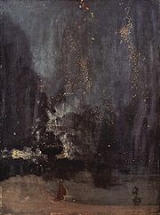
Nocturne in Black and Gold – The Falling Rocket
Encyclopedia
Nocturne in Black and Gold – The Falling Rocket is an 1870s painting by James Abbott McNeill Whistler. It depicts a fireworks
show in the night sky over Battersea Bridge
in an industrial London
city park.
This painting was first shown at the Grosvenor Gallery
in London in 1877. It is the last of the London Nocturnes and is now widely acknowledged to be the high point of Whistler's middle period.
The gold flecks and splatters represent the exploded fireworks in the night sky. The fireworks light up the sky, producing a glow in the thick air and billowing smoke. The artist was more interested in conveying atmospheric effects than he was in providing details of the actual scene.
Whistler manages to paint darkness while retaining the right degree of colour-laden luminosity
. There is a sense of spatial ambiguity set against a structure of line and form. The contradictory qualities of energy and stillness are combined here.
The painting was controversial. Art critic John Ruskin
criticized the painting harshly, commenting that "The ill-educated conceit of the artist... approached the aspect of willful imposture... I have seen, and heard, much of Cockney impudence before now; but never expected to hear a coxcomb ask two hundred guineas for flinging a pot of paint in the public's face." In response to the comments, Whistler sued Ruskin for libel. Whistler won the suit, but was awarded only trivial damages. It has been suggested John Ruskin
suffered from CADASIL
and the visual disturbances this condition caused him might have been a factor in his irritation at this particular painting.
Fireworks
Fireworks are a class of explosive pyrotechnic devices used for aesthetic and entertainment purposes. The most common use of a firework is as part of a fireworks display. A fireworks event is a display of the effects produced by firework devices...
show in the night sky over Battersea Bridge
Battersea Bridge
Battersea Bridge is a cast-iron and granite five-span cantilever bridge crossing the River Thames in London, England. It is situated on a sharp bend in the river, and links Battersea south of the river with Chelsea to the north...
in an industrial London
London
London is the capital city of :England and the :United Kingdom, the largest metropolitan area in the United Kingdom, and the largest urban zone in the European Union by most measures. Located on the River Thames, London has been a major settlement for two millennia, its history going back to its...
city park.
This painting was first shown at the Grosvenor Gallery
Grosvenor Gallery
The Grosvenor Gallery was an art gallery in London founded in 1877 by Sir Coutts Lindsay and his wife Blanche. Its first directors were J. Comyns Carr and Charles Hallé...
in London in 1877. It is the last of the London Nocturnes and is now widely acknowledged to be the high point of Whistler's middle period.
The gold flecks and splatters represent the exploded fireworks in the night sky. The fireworks light up the sky, producing a glow in the thick air and billowing smoke. The artist was more interested in conveying atmospheric effects than he was in providing details of the actual scene.
Whistler manages to paint darkness while retaining the right degree of colour-laden luminosity
Luminosity
Luminosity is a measurement of brightness.-In photometry and color imaging:In photometry, luminosity is sometimes incorrectly used to refer to luminance, which is the density of luminous intensity in a given direction. The SI unit for luminance is candela per square metre.The luminosity function...
. There is a sense of spatial ambiguity set against a structure of line and form. The contradictory qualities of energy and stillness are combined here.
The painting was controversial. Art critic John Ruskin
John Ruskin
John Ruskin was the leading English art critic of the Victorian era, also an art patron, draughtsman, watercolourist, a prominent social thinker and philanthropist. He wrote on subjects ranging from geology to architecture, myth to ornithology, literature to education, and botany to political...
criticized the painting harshly, commenting that "The ill-educated conceit of the artist... approached the aspect of willful imposture... I have seen, and heard, much of Cockney impudence before now; but never expected to hear a coxcomb ask two hundred guineas for flinging a pot of paint in the public's face." In response to the comments, Whistler sued Ruskin for libel. Whistler won the suit, but was awarded only trivial damages. It has been suggested John Ruskin
John Ruskin
John Ruskin was the leading English art critic of the Victorian era, also an art patron, draughtsman, watercolourist, a prominent social thinker and philanthropist. He wrote on subjects ranging from geology to architecture, myth to ornithology, literature to education, and botany to political...
suffered from CADASIL
CADASIL
CADASIL is the most common form of hereditary stroke disorder, and is thought to be caused by mutations of the Notch 3 gene on chromosome 19. The disease belongs to a family of disorders called the Leukodystrophies...
and the visual disturbances this condition caused him might have been a factor in his irritation at this particular painting.

